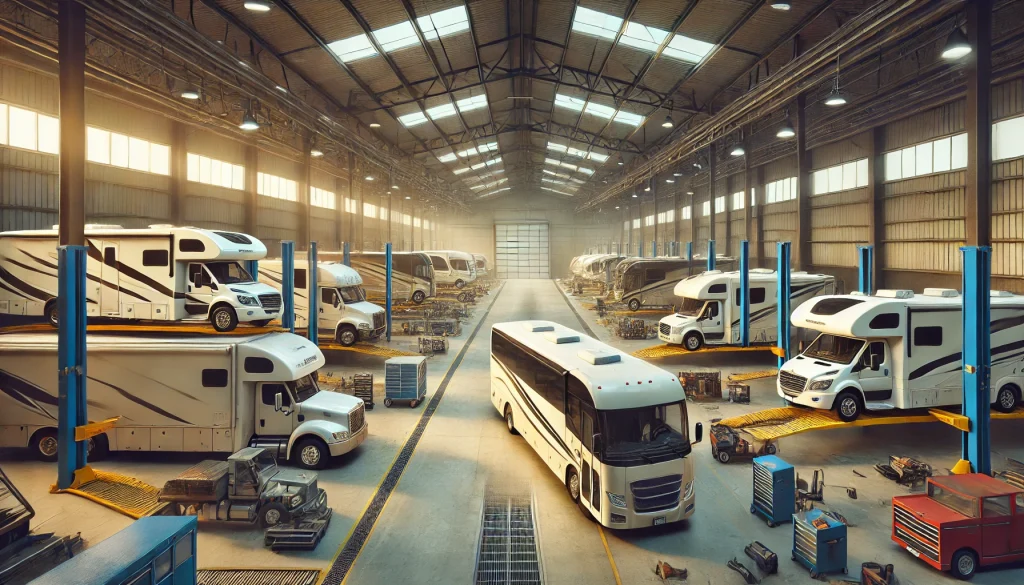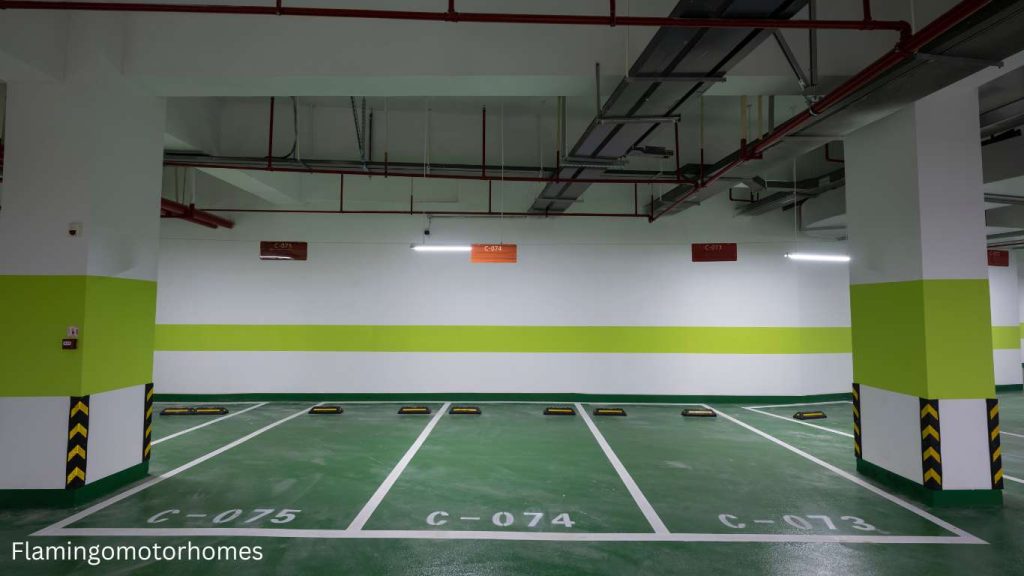How much it takes or costs to store a motorhome well storing a motorhome is an essential consideration for owners who want to protect their investment when not in use. Discover the average cost of storing a motorhome, including factors that affect pricing, types of storage options, and tips to save money. Make an informed decision for secure and affordable motorhome storage. The cost varies widely based on several factors. Let’s break it down for you.

Factors Affecting Motorhome Storage Costs
1. Type of Storage Facility
- Outdoor Storage: Typically the most affordable option, ranging from $30 to $100 per month, depending on location and amenities.
- Covered Storage: Offers partial protection from the elements, costing around $50 to $200 monthly.
- Indoor Storage: The premium choice, offering full protection at a cost of $100 to $400 per month.

2. Location depending cost
- Urban areas tend to have higher storage costs than rural locations due to demand and real estate pricing.
3. Motorhome Size
- Larger motorhomes require more space, often increasing costs by 10-20% for oversized units for storage cost for motorhome.
Additional Costs of Motorhome Storage
- Security Features: Facilities with 24/7 surveillance or gated access might charge extra, ranging from $10 to $50 more per month.
- Climate-Controlled Storage: Ideal for protecting sensitive components, adding $50 to $150 to the monthly fee.
- Seasonal Rates: Prices can fluctuate based on demand during peak storage seasons.
Cost-Saving Tips for Motorhome Storage
- Off-Season Discounts: Look for promotions during low-demand months.
- Long-Term Contracts: Some facilities offer reduced rates for long-term commitments.
- Shared Spaces: Sharing a storage unit with another vehicle owner can split costs significantly.

How Much Does It Cost to Store a Motorhome by Class?
The cost to store a motorhome varies not only by storage type but also by the motorhome class. Each class—Class A, Class B, and Class C—differs in size and requirements, impacting storage pricing for storage cost for motorhome.
Motorhome Storage Costs for Class A
- Key Phrase Length: 5 words
- Average Cost: $150 to $400 per month
Class A motorhomes are the largest, typically 30 to 45 feet long. Their size and weight demand more spacious and specialized storage, often leading to premium pricing.

Motorhome Storage Costs for Class B
- Key Phrase Length: 5 words
- Average Cost: $50 to $200 per month
Class B motorhomes, often called camper vans, are compact and easier to store. They can fit in smaller spaces, making them a budget-friendly option for storage facilities.
Motorhome Storage Costs for Class C
- Key Phrase Length: 5 words
- Average Cost: $100 to $300 per month
Class C motorhomes fall between Classes A and B in size, ranging from 20 to 30 feet. Their moderate size often means mid-tier storage pricing for storage cost for motorhome.

How Motorhome Size Influences Storage cost Options
1. Outdoor Storage for All Classes:
- Suitable for all motorhome classes but best for durable models.
- Costs range from $30 to $150 per month, with Class A being the most expensive.
2. Covered Storage for Class A and C:
- Provides partial protection at $50 to $250 monthly, depending on size.
- Class B motorhomes may benefit less due to their compact design.
3. Indoor Storage for High-End Motorhomes:
- Preferred for Class A and luxury Class C motorhomes.
- Pricing starts at $150 per month and can go up to $500 for large units.

Tips for Choosing Storage Based on Motorhome Class
- Class A Owners: Opt for indoor or covered storage to protect your significant investment for storage cost for motorhome.
- Class B Owners: Take advantage of compact size to save on costs with outdoor or smaller indoor spaces.
- Class C Owners: Evaluate your climate needs; covered storage might strike a perfect balance between protection and affordability.
Why Consider Storage Costs by Motorhome Class?
Understanding costs specific to your motorhome class helps you budget effectively while ensuring the best care for your vehicle. Proper storage not only maintains your motorhome’s condition but also enhances its resale value.
Types of Storage cost for Different Motorhome Sizes: Which Is Best?
Storing your motorhome properly ensures its longevity and usability. The type of storage you choose depends on your motorhome’s size, budget, and local climate. Here’s a breakdown of the storage types, their suitability for different motorhome sizes, and the pros and cons of each.
1. Outdoor Storage
Best For: Class B and small Class C motorhomes.
Cost: $30–$150 per month.
Outdoor storage involves parking your motorhome in a designated open lot.
Pros:
- Affordable: Lowest-cost option.
- Easily Available: Widely accessible across urban and rural areas.
Cons:
- Weather Exposure: Prone to damage from sun, rain, and snow.
- Security Risks: Less secure than covered or indoor options.
Recommendation: Best for budget-conscious owners in mild climates. Use a quality cover to mitigate weather exposure for storage cost for motorhome.

2. Covered Storage
Best For: Class C and small-to-medium Class A motorhomes.
Cost: $50–$250 per month.
Covered storage provides a roof or canopy to shield the motorhome from direct sunlight and precipitation.
Pros:
- Moderate Protection: Shields against UV rays and minor weather effects for storage cost for motorhome.
- Cost-Effective: Cheaper than indoor storage while offering better protection than outdoor storage.
Cons:
- Partial Exposure: Doesn’t protect against wind-driven rain or extreme cold.
- Space Constraints: May not accommodate very large motorhomes.
Recommendation: Ideal for mid-size motorhomes in regions with mild winters and hot summers.

3. Indoor Storage
Best For: Large Class A motorhomes and luxury models.
Cost: $150–$500 per month.
Indoor storage includes fully enclosed units that provide maximum protection.
Pros:
- Complete Protection: Safeguards against weather, pests, and vandalism.
- Climate Control: Some facilities offer temperature-regulated environments, ideal for sensitive components.
Cons:
- Expensive: Highest cost among storage options.
- Limited Availability: Not all facilities accommodate oversized motorhomes.
Recommendation: Best for large, high-value motorhomes or in areas with harsh weather conditions.
4. Driveway or Home Storage
Best For: Class B and small Class C motorhomes.
Cost: Free (if space is available).
Home storage involves keeping the motorhome in your driveway or backyard or storage facility.
Pros:
- Convenient: Always accessible for maintenance or trips.
- Cost-Free: Eliminates storage fees.
Cons:
- Space Restrictions: Not feasible for larger motorhomes.
- Local Regulations: Some neighborhoods have restrictions on motorhome parking.
Recommendation: Suitable for compact motorhomes and owners with ample space at home for storage cost for motorhome.

Best Storage Option: Indoor Storage for Maximum Protection
If your budget allows, indoor storage is the best option. It provides unparalleled protection against weather, theft, and pests, ensuring your motorhome remains in pristine condition. However, for budget-conscious owners or those with smaller motorhomes, covered storage is a practical middle ground.
Summary of Pros and Cons
| Type of Storage | Pros | Cons |
| Outdoor Storage | Affordable, widely available | Weather exposure, less secure |
| Covered Storage | Moderate protection, cost-effective | Partial exposure, limited for large RVs |
| Indoor Storage | Complete protection, climate control | Expensive, limited availability |
| Driveway/Home Storage | Free, convenient | Space restrictions, local regulations |
Motorhome Storage Cost Comparison Table
Below is a comprehensive table summarizing the storage costs for different classes of motorhomes, based on storage type:
| Storage Type | Class A (Large) | Class B (Compact) | Class C (Medium) |
| Outdoor Storage | $50–$150/month | $30–$100/month | $40–$120/month |
| Covered Storage | $100–$300/month | $50–$150/month | $70–$200/month |
| Indoor Storage | $200–$500/month | $100–$250/month | $150–$400/month |
| Driveway/Home Storage | Free (if available) | Free (if available) | Free (if available) |
Key Takeaways
- Class A Motorhomes: Highest costs due to their size, especially for indoor or covered storage.
- Class B Motorhomes: Most affordable to store, suitable for all storage types.
- Class C Motorhomes: Moderate costs that vary based on size and storage needs.
Why Do We Need to Store Different Classes of Motorhomes?
Storing motorhomes, regardless of their class, is crucial for maintaining their condition, ensuring safety, and maximizing their longevity. Each class—A, B, or C—has specific reasons for requiring proper storage based on size, design, and functionality. Let’s explore why storage is essential for storage cost for motorhome.

1. Class A Motorhomes
Reason:
Class A motorhomes are the largest and most luxurious, often equipped with advanced electronics, expensive furnishings, and sensitive mechanical components.
Why Store Them?
- Weather Protection: Exposure to extreme weather, such as sun, rain, or snow, can damage the exterior and fade paint.
- Preventing Theft or Vandalism: Due to their high value, they are a target for theft. Proper storage reduces this risk.
- Maintenance of Sensitive Equipment: Climate-controlled storage prevents damage to appliances and plumbing during freezing or hot temperatures.
2. Class B Motorhomes
Reason:
Class B motorhomes, also known as camper vans, are compact but still require care due to their smaller footprint and built-in amenities.
Why Store Them?
- Space Management: Parking at home might be impractical due to limited space.
- Protection from Wear and Tear: Even compact motorhomes face wear from weather and pests if left unprotected.
- Convenience for Urban Owners: Storage facilities offer a secure option when home parking isn’t available.
3. Class C Motorhomes
Reason:
Class C motorhomes blend the features of Class A and Class B. Their moderate size still demands storage to protect structural and functional integrity.
Why Store Them?
- Preserve Resale Value: Proper storage prevents degradation, maintaining resale value over time.
- Protection from Seasonal Damage: Rain, snow, and UV rays can deteriorate the roof and seals.
- Compliance with Local Laws: Many communities restrict parking of large vehicles in residential areas, making off-site storage necessary.
Additional Benefits of Motorhome Storage
- Extended Lifespan: Proper storage minimizes exposure to factors that accelerate aging.
- Cost Savings: Protecting your motorhome reduces the need for frequent repairs and replacements.
- Peace of Mind: Knowing your motorhome is in a secure, protected environment allows for worry-free ownership.
Why Proper Storage is a Must
Storing your motorhome, regardless of its class, ensures it remains road-ready, safe, and in top condition for your next adventure. Investing in proper storage is not just a convenience—it’s a critical step in responsible ownership.

Problems of Not Storing Different Classes of Motorhomes
Failing to store your motorhome properly can lead to a range of issues, regardless of whether you own a Class A, B, or C motorhome. These problems impact your vehicle’s condition, usability, and overall value. Below is a breakdown of common problems and their solutions for each motorhome class.

1. Problems for Class A Motorhomes
Problems:
- Weather Damage: The large exterior surface is vulnerable to UV rays, rain, and snow, which can fade paint, crack seals, and cause leaks.
- Tire Deterioration: Prolonged exposure to heat or cold can lead to tire cracking or flat spots.
- Theft and Vandalism: High value makes these motorhomes a prime target.
Solutions:
- Indoor or Covered Storage: Protects against weather and minimizes exposure to harmful elements.
- Tire Covers and Elevation Blocks: Prevent tire damage by shielding them from UV rays and distributing weight evenly.
- Secure Storage Facilities: Opt for a facility with surveillance and gated access to reduce theft risks.
2. Problems for Class B Motorhomes
Problems:
- Space Constraints: Compact motorhomes are often parked in driveways or streets, making them vulnerable to accidents or local parking violations.
- Moisture Build-Up: Poor ventilation when stored outdoors can lead to mold and mildew in the smaller interior space.
- Rust and Corrosion: Exposure to rain or snow accelerates rusting of the body and undercarriage.
- Solutions:
- Covered Parking Spaces: A canopy or carport offers affordable protection for Class B motorhomes.
- Dehumidifiers and Ventilation: Use a portable dehumidifier to control interior moisture levels.
- Rust Protection Coating: Apply anti-rust coatings on exposed metal parts to prevent corrosion.
3. Problems for Class C Motorhomes
Problems:
- Roof Damage: Medium-sized motorhomes are susceptible to roof leaks if seals degrade due to weather.
- Pest Infestation: Mice, insects, and birds may nest in or damage the vehicle when parked in open areas.
- Battery Drain: Extended periods of disuse can drain the battery, affecting electronics and ignition systems.
Solutions:
- Regular Seal Inspections: Check and repair seals to prevent water ingress.
- Pest Deterrents: Use natural deterrents or traps to avoid infestations.
- Battery Maintenance: Disconnect the battery or use a trickle charger to maintain charge during storage.
General Problems Across All Motorhome Classes
| Problem | Impact | Solution |
| Weather Exposure | Fading paint, cracks, and leaks | Indoor or covered storage, protective covers |
| Pest Infestation | Interior damage, wiring issues | Pest-proofing with traps and sealants |
| Vandalism/Theft | Financial loss, potential vandalism | Secure storage facilities with 24/7 monitoring |
| Mechanical Issues | Rust, battery drain, and tire damage | Regular maintenance, anti-rust coatings, battery care |
| Legal Restrictions | Fines for violating local parking laws | Use off-site storage facilities that comply with laws |
Any further related information or detail will be available on Flamingo Motorhomes

